Baits for catching predatory fish — fish nozzles
Predators are well attracted by nozzles from freshwater and marine fish of different species.
 You can catch live bait very quickly with the lifter. |
In the menu of all predators, small fish occupies an important place. But first you need to catch her. The easiest way to do this is with a light rod or a lifter. In promising places, the net is lowered into the water, they wait for a few minutes, and then they are lifted together with the prey. Bait from lightly moistened breadcrumbs or powdered milk attracts fish trifles to the lifter. A trifle is also caught on a rod with a blind snap (fishing line with a diameter of 0.12 mm, hooks No. 16-20) with one small maggot on the hook. If only large specimens are caught while fishing for «small things», then the predator is caught on a piece of fish. You can catch pike, walleye, eel or perch on it. The pieces should be long and narrow. They are cut from the sides of the fish, making an incision first behind the gills, and then cutting the fish with a sharp knife along the ridge to the tail. The piece is pierced with a hook only once at the thickened end. The disadvantage of such a nozzle is that it quickly loses its taste qualities — it is «washed out» and it has to be replaced every half hour.
 Fish pieces are a great bait not only for perches. Unfortunately, they are quickly «washed out», so they have to be replaced regularly. |
 This is how the fish is impaled with a nozzle needle (1). 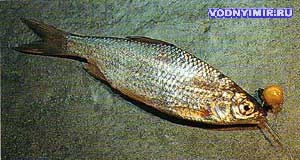 If you fix a fish with a corn grain on the sting, it will not fly off the hook during a power cast. |
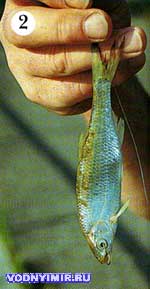 The hook looks out from the corner of the mouth and reliably detects eel and walleye (2). |
The method of planting a whole fish depends on what kind of predator it is going to catch. If there is an eel and a walleye, then it is impaled with a nozzle needle. The loop of the leash is inserted into the eye of the needle and passed through the mouth of a dead fish, the central bones of the spine and again brought out between the anus and the root of the tail. The hook is placed in the mouth. Grabbing such a tackle, the predator will certainly detect itself.
When fishing in the river, the fish should be planted behind the nostril so that it behaves naturally on the current. Dead fish, attached to a hook behind the back, look unnatural in flowing water. If you stick a fish behind the nostril, then with power throws the bait for fishing can fly off the hook. To avoid this, a stopper will help — a piece of rubber put on the sting. If there is no rubber at hand, you can use a grain of hard corn instead.
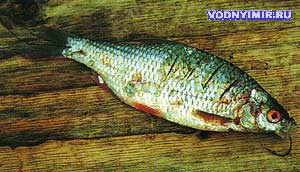 To make more odorous tissue fluid in the water, experts make vertical incisions on the body of the fish on both sides. 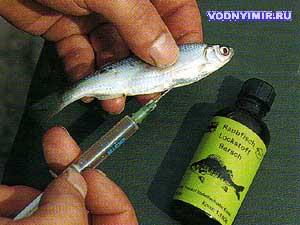 Aromatic attack: English specialists in catching predatory fish inject attractants under the skin of a dead fish. |
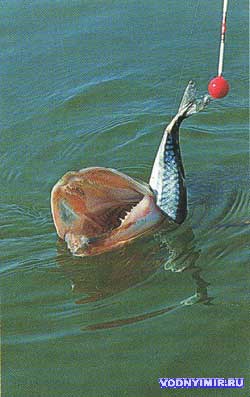 Herring, smelt or half of mackerel provoke the bite of a large pike. |
Some more tips when catching predatory fish
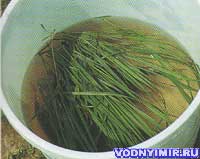 A bunch of grass serves as a shelter for the fish, so they don't jump out of the bucket. |
To prevent the newly caught live bait from jumping out of the bucket, you need to put some kind of obstacle in their way. Put, for example, a little grass on the surface of the water, then the fry will feel calmer and will jump less.
Walleye like strong-smelling bait, so professionals-«walleye» make vertical incisions on dead fish so that more tissue fluid comes out into the water. In addition, the fish can be treated with an attractant, which is injected under the skin with a disposable syringe.
Perch are cannibals. They willingly eat their offspring. Therefore, if you manage to get small perches, then you can offer them to a predator on a float rig.
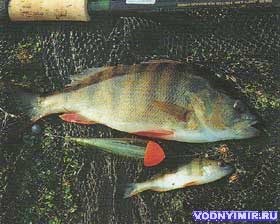 Large perches are well caught with a float rod with perch juveniles on a hook. |
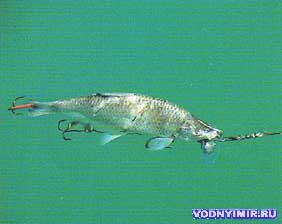 Tackle with dead fish on spinning. |
Sea fish: herring, mackerel and smelt come across large pike. English specialists successfully catch them with bottom gear in gravel quarry lakes and rivers. They carry out a tackle with a dead fish in the same way as a spinning bait. Moreover, a dead fish has a huge advantage over artificial baits: when a predator grabs a fish, he lets it go less often, since this is real food, and not a foul-smelling fake.
Share this page in the social. networks or bookmark:
